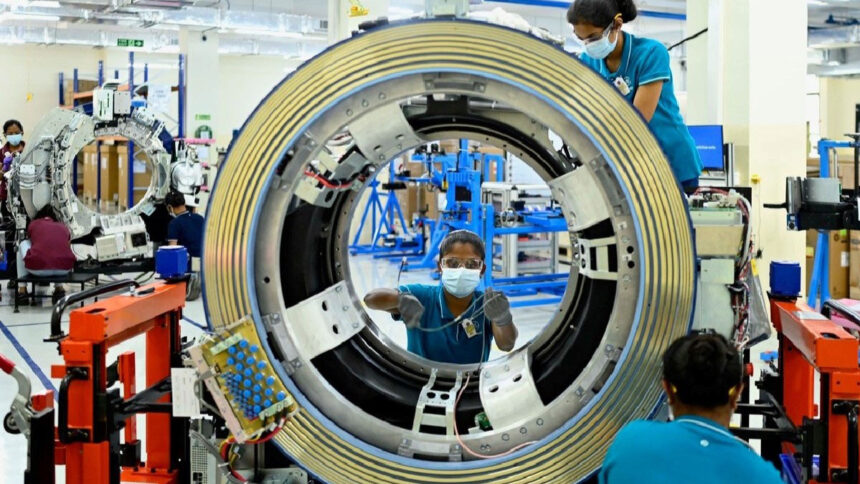Introduction: A Global Shift in the Making
China was the manufacturing powerhouse of the world over the past 20 years. Made in China was a brand that nobody would dispute: for semiconductors, smartphones, furniture, or fashion. But with the emergence of global geopolitical issues, supply chains realign, and economies desire resilience rather than affordability, a new narrative is set to become a reality- Make in India 2.0. India appears no longer as a just a billion consumer market to the global leading corporations, they are now betting on it as a strategic manufacturing location.
A slogan of yesterday has become a multi-dimensional policy construct that is transforming the role of India in the international economy structure. The Government of India has embarked on a resurgent rejuvenation of its manufacturing sector across the country in a future-proof strategy putting it on the radar of multinational investors who lost interest in China and its perils of excessive dependency.
The Evolution of Make in India: From Policy to Practice
The concept of the original Make in India scheme, initiated in 2014, was to turn India into a global venue of designing and manufacturing. It boasted of initial successes but critics made numerous references to the bureaucratic setbacks, infrastructural delays, and implementation shortcomings.
However, Make in India 2.0 is not a reiteration of previous policies, rather a re-invented economic plan. The second wave is aimed at:
- Production-Linked Incentive (PLI) plans on 14 settings
- The streamlining of the process of doing business through digital clearances and less compliance burden
- Smart Infrastructure, say in the form of National Logistics Policy and PM Gati Shakti
- Up-gradation of the workforce through industrial mission-based skill development in consonance with Industry 4.0
- Export orientation and bilateral trade (such as India-UAE CEPA, Australia-India ECTA)
As geopolitical volatility has been increasing, these structural changes have made India a safer, sustainable alternative where other manufacturers globally want to de-risk China.
Why Are Global Companies Choosing India Over China?
1. Geopolitical Realignments
Causes of increased adoption of the China Plus One strategy: US-China trade tensions, unstable Taiwan Strait, and concerns regarding China regulatory environment by the West. India and its democratic institutions, stable macroeconomic indicators, and transparent legal system have become an attractive alternative.
Other countries like the United States, Japan and South Korea are now eager to collaborate with India in the fields of manufacturing, defense, and technology-it is becoming a component of their strategic supply chain reconfiguration.
2. Youthful Demographics and Competitive Labor.
India has the highest number of working population. More than 600 million citizens aged below 35 look to expand the economy of India, not only as a source of cheap labor but also a future customer base of EVs to electronics.
By contrast, China is experiencing a graying population and a declining workforce and its manufacturing edge is eroding due to high labor costs.
3. Digital Infrastructure Policy Innovation
Services such as Digital India, Aadhaar, and UPI have reshaped the way services are provided and have also developed a business ecosystem based on digital first, which global firms find attractive due to handiness and clarity.
Further, official websites such as National Single Window System (NSWS) and e-Shram are easing the regulation procedures and foreign companies are finding it easier to establish their business in India.
India’s Sectoral Strengths in Make in India 2.0
Semiconductors and Electronics
Apple, Samsung and Foxconn have shown a fast-growing investment in production plants in India. Micron Technology, Applied Materials, and other chipmakers across the globe are being attracted by the 10 billion dollars semiconductor incentive program being offered by the Indian government.
Automotive And Electric Vehicles (EVs)
One of the leading electric car producers Tesla is said to be close to establishing a plant in India, and domestic producers, such as Tata Motors, are already exporting EVs to other countries. Maruti Suzuki and Hyundai are also saying they are investing hugely in green mobility.
Drugs and Biotechnology
Already India is referred to as the Pharmacy of the World. Now, after COVID, efforts have increased to build Bulk drug parks and biotech clusters, to end reliance on Chinese APIs (Active Pharmaceutical Ingredients).
Defense and Aerospace
As defense exports exceeded the 2.6 billion mark in FY24, India got the favor of global defense giants such as Boeing, Lockheed Martin, and Dassault Aviation. The collaborations entail the production of aircraft parts, drones, and next-generation weapon systems.
Consumer electronics and IT Hardware
Dell, HP, and Lenovo are continuing their assembly line in India. The scheme of PLI in IT hardware sets a goal of 2026 when the initiative should manufacture more than 25 billion dollars worth of goods.
Case Studies: Global Companies Betting Big on India

Apple Inc.
In 2023, Apple started assembling more than 7% of its iPhones in India, which is projected to hit 25 % in 2026. Its manufacturers Foxconn, Wistron and Pegatron are on the brink of building giant factories in the states of Tamil Nadu and Karnataka.
Micron Technology
Another key development occurred in 2024 when the US-based semiconductor giant announced a $2.75 billion facility in Gujarat, India in taking the first step into the global silicon supply chain.
Samsung
The body of Samsung phone manufacturing factory in Noida is currently the largest mobile phone manufacturing factory in the world, where millions of units are manufactured and marketed per year to the local and international markets.
Siemens Energy
The German giant has increased its stake in the renewable industry in India two-fold by establishing units to make wind turbines in Tamil Nadu and Gujarat.
Challenges That Remain
Nonetheless, there are obstacles. Some investors still worry about land acquisition delays and differing inter-state policies, and ineffective bureaucracy. Further, though the infrastructure is getting better, it must be executed quicker in Tier II and III areas.
Power supply, customs clearance, and logistics should not stop evolving to the standards of the manufacturing hubs such as Vietnam, Thailand, as well as, of course, China.
Saying as much, the government being proactive in approaching the sector, Invest India, Startup India, and frequent engagements with CII-FICCI on the subject, are signs that reforms are more a process than announcements.
India in the World News: A Strategic Pivot
India is an economic powerhouse that is emerging as a desirable manufacturing destination as well as a geo-strategy powerhouse. The nation is also engaged in international forums such as G20, Quad, BRICS or Indo-Pacific Economic Framework (IPEF) increasingly, leading to a change that has been described as the replacement of soft diplomacy with hard economics.
The amount of Foreign Direct Investment (FDI) inflow has surpassed the 83 billion dollar threshold, and the grand presence of India in the global supply chains (the source of World News story writing and reading on this international enterprise inclusion has become mainstream news).
This is not merely an Indian moment, but it is the re-definition of trading patterns in the world.
The Future of Make in India 2.0
With the world rebalancing itself in the wake of COVID, amid war, trade wars, and tech wars, India is no longer banging on the door of the global economy, it is being ushered in.
Make in India 2.0 is backed by policy reality, geo-economic potential, and young aspirations. Not only does it put the country on the map as an alternative to China, but also as a trustworthy, democratic, and scalable trade partner in worldwide manufacturing.
India might not leap-frog China tomorrow–but it is in no small measure emerging as a major force in the world of multipolar manufacturing. This transition provides fresh realms of prosperity, collaboration and development to investors, policymakers as well as citizens.
To receive information on how India is transforming world business, continue reading The Vue Times.










